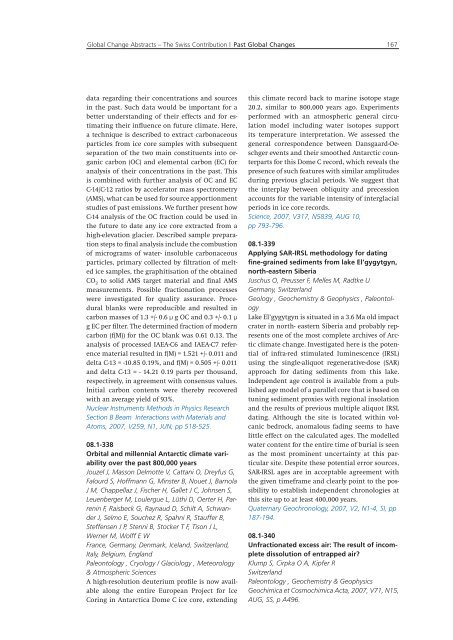Global Change Abstracts The Swiss Contribution - SCNAT
Global Change Abstracts The Swiss Contribution - SCNAT
Global Change Abstracts The Swiss Contribution - SCNAT
You also want an ePaper? Increase the reach of your titles
YUMPU automatically turns print PDFs into web optimized ePapers that Google loves.
<strong>Global</strong> <strong>Change</strong> <strong>Abstracts</strong> – <strong>The</strong> <strong>Swiss</strong> <strong>Contribution</strong> | Past <strong>Global</strong> <strong>Change</strong>s<br />
data regarding their concentrations and sources<br />
in the past. Such data would be important for a<br />
better understanding of their effects and for estimating<br />
their influence on future climate. Here,<br />
a technique is described to extract carbonaceous<br />
particles from ice core samples with subsequent<br />
separation of the two main constituents into organic<br />
carbon (OC) and elemental carbon (EC) for<br />
analysis of their concentrations in the past. This<br />
is combined with further analysis of OC and EC<br />
C-14/C-12 ratios by accelerator mass spectrometry<br />
(AMS), what can be used for source apportionment<br />
studies of past emissions. We further present how<br />
C-14 analysis of the OC fraction could be used in<br />
the future to date any ice core extracted from a<br />
high-elevation glacier. Described sample preparation<br />
steps to final analysis include the combustion<br />
of micrograms of water- insoluble carbonaceous<br />
particles, primary collected by filtration of melted<br />
ice samples, the graphitisation of the obtained<br />
CO 2 to solid AMS target material and final AMS<br />
measurements. Possible fractionation processes<br />
were investigated for quality assurance. Procedural<br />
blanks were reproducible and resulted in<br />
carbon masses of 1.3 +/- 0.6 µ g OC and 0.3 +/- 0.1 µ<br />
g EC per filter. <strong>The</strong> determined fraction of modern<br />
carbon (f(M)) for the OC blank was 0.61 0.13. <strong>The</strong><br />
analysis of processed IAEA-C6 and IAEA-C7 reference<br />
material resulted in f(M) = 1.521 +/- 0.011 and<br />
delta C-13 = -10.85 0.19%, and f(M) = 0.505 +/- 0.011<br />
and delta C-13 = - 14.21 0.19 parts per thousand,<br />
respectively, in agreement with consensus values.<br />
Initial carbon contents were thereby recovered<br />
with an average yield of 93%.<br />
Nuclear Instruments Methods in Physics Research<br />
Section B Beam Interactions with Materials and<br />
Atoms, 2007, V259, N1, JUN, pp 518-525.<br />
08.1-338<br />
Orbital and millennial Antarctic climate variability<br />
over the past 800,000 years<br />
Jouzel J, Masson Delmotte V, Cattani O, Dreyfus G,<br />
Falourd S, Hoffmann G, Minster B, Nouet J, Barnola<br />
J M, Chappellaz J, Fischer H, Gallet J C, Johnsen S,<br />
Leuenberger M, Loulergue L, Lüthi D, Oerter H, Parrenin<br />
F, Raisbeck G, Raynaud D, Schilt A, Schwander<br />
J, Selmo E, Souchez R, Spahni R, Stauffer B,<br />
Steffensen J P, Stenni B, Stocker T F, Tison J L,<br />
Werner M, Wolff E W<br />
France, Germany, Denmark, Iceland, Switzerland,<br />
Italy, Belgium, England<br />
Paleontology , Cryology / Glaciology , Meteorology<br />
& Atmospheric Sciences<br />
A high-resolution deuterium profile is now available<br />
along the entire European Project for Ice<br />
Coring in Antarctica Dome C ice core, extending<br />
167<br />
this climate record back to marine isotope stage<br />
20.2, similar to 800,000 years ago. Experiments<br />
performed with an atmospheric general circulation<br />
model including water isotopes support<br />
its temperature interpretation. We assessed the<br />
general correspondence between Dansgaard-Oeschger<br />
events and their smoothed Antarctic counterparts<br />
for this Dome C record, which reveals the<br />
presence of such features with similar amplitudes<br />
during previous glacial periods. We suggest that<br />
the interplay between obliquity and precession<br />
accounts for the variable intensity of interglacial<br />
periods in ice core records.<br />
Science, 2007, V317, N5839, AUG 10,<br />
pp 793-796.<br />
08.1-339<br />
Applying SAR-IRSL methodology for dating<br />
fine-grained sediments from lake El’gygytgyn,<br />
north-eastern Siberia<br />
Juschus O, Preusser F, Melles M, Radtke U<br />
Germany, Switzerland<br />
Geology , Geochemistry & Geophysics , Paleontology<br />
Lake El’gygytgyn is situated in a 3.6 Ma old impact<br />
crater in north- eastern Siberia and probably represents<br />
one of the most complete archives of Arctic<br />
climate change. Investigated here is the potential<br />
of infra-red stimulated luminescence (IRSL)<br />
using the single-aliquot regenerative-dose (SAR)<br />
approach for dating sediments from this lake.<br />
Independent age control is available from a published<br />
age model of a parallel core that is based on<br />
tuning sediment proxies with regional insolation<br />
and the results of previous multiple aliquot IRSL<br />
dating. Although the site is located within volcanic<br />
bedrock, anomalous fading seems to have<br />
little effect on the calculated ages. <strong>The</strong> modelled<br />
water content for the entire time of burial is seen<br />
as the most prominent uncertainty at this particular<br />
site. Despite these potential error sources,<br />
SAR-IRSL ages are in acceptable agreement with<br />
the given timeframe and clearly point to the possibility<br />
to establish independent chronologies at<br />
this site up to at least 400,000 years.<br />
Quaternary Geochronology, 2007, V2, N1-4, SI, pp<br />
187-194.<br />
08.1-340<br />
Unfractionated excess air: <strong>The</strong> result of incomplete<br />
dissolution of entrapped air?<br />
Klump S, Cirpka O A, Kipfer R<br />
Switzerland<br />
Paleontology , Geochemistry & Geophysics<br />
Geochimica et Cosmochimica Acta, 2007, V71, N15,<br />
AUG, SS, p A496.

















